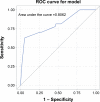Prediction of biological behavior and prognosis of colorectal cancer patients by tumor MSI/MMR in the Chinese population
- PMID: 27994472
- PMCID: PMC5153316
- DOI: 10.2147/OTT.S117089
Prediction of biological behavior and prognosis of colorectal cancer patients by tumor MSI/MMR in the Chinese population
Abstract
Colorectal cancers (CRCs) exhibiting microsatellite instability (MSI) have special biological behavior. The clinical predictors for MSI and its survival relevance for the Chinese population were still unclear. Seven hundred ninety-five CRC patients were retrospectively assessed. Mismatch repair (MMR) proteins (MSH2, MSH6, PMS1, and MLH1) expression was detected by immunohistochemistry using tumor tissues of all patients. DNA MSI status was analyzed by polymerase chain reaction in 182 samples randomly selected from the 795 cases. Among all CRC tumor tissues, 97 cases (12.2%) were with an MMR protein-deficient (MMR-D) phenotype, whereas 698 cases (87.8%) were with an MMR proteins intact (MMR-I) phenotype. A total of 21 (11.5%) CRCs were identified as having high microsatellite instability, 156 (85.7%) tumors were having microsatellite stability (MSS), and five (2.7%) were having low microsatellite instability. Importantly, MMR status was demonstrated to be moderately consistent with MSI status (κ=0.845, 95% confidence interval [CI] 0.721, 0.969). Unconditional logistic regression analysis revealed age, number of lymph node, tumor diameter, and tumor site as predictors for MSI with a substantial ability to discriminate different MSI status by area under curve of 80.62% using receiver operation curve. Compared with MMR-I, MMR-D was an independent prognostic factor for longer overall survival (hazard ratio =0.340, 95% CI 0.126, 0.919; P=0.034). MMR-D is an independent prognostic factor for better outcome. Our results may provide evidence for individualized diagnosis and treatment of CRC, but this will require further validation in larger sample studies.
Keywords: clinicopatho-logical features; microsatellite instability; mismatch repair; prognosis; sporadic colorectal cancer.
Conflict of interest statement
The authors report no conflicts of interest in this work.
Figures





Similar articles
-
Extended microsatellite analysis in microsatellite stable, MSH2 and MLH1 mutation-negative HNPCC patients: genetic reclassification and correlation with clinical features.Digestion. 2004;69(3):166-76. doi: 10.1159/000078223. Epub 2004 Apr 28. Digestion. 2004. PMID: 15118395
-
Phenotypic attributes and survival in mismatch repair deficient/microsatellite instability-high colorectal carcinomas.World J Clin Oncol. 2025 Jun 24;16(6):104243. doi: 10.5306/wjco.v16.i6.104243. World J Clin Oncol. 2025. PMID: 40585832 Free PMC article.
-
Microsatellite instability and novel mismatch repair gene mutations in northern Chinese population with hereditary non-polyposis colorectal cancer.Chin J Dig Dis. 2006;7(4):197-205. doi: 10.1111/j.1443-9573.2006.00269.x. Chin J Dig Dis. 2006. PMID: 17054581
-
Implications of mismatch repair-deficient status on management of early stage colorectal cancer.J Gastrointest Oncol. 2015 Dec;6(6):676-84. doi: 10.3978/j.issn.2078-6891.2015.065. J Gastrointest Oncol. 2015. PMID: 26697201 Free PMC article. Review.
-
Microsatellite instability and DNA mismatch repair deficiency testing in hereditary and sporadic gastrointestinal cancers.Clin Lab Med. 2005 Mar;25(1):179-96. doi: 10.1016/j.cll.2004.12.001. Clin Lab Med. 2005. PMID: 15749237 Review.
Cited by
-
Radiomics Analysis of Iodine-Based Material Decomposition Images With Dual-Energy Computed Tomography Imaging for Preoperatively Predicting Microsatellite Instability Status in Colorectal Cancer.Front Oncol. 2019 Nov 22;9:1250. doi: 10.3389/fonc.2019.01250. eCollection 2019. Front Oncol. 2019. PMID: 31824843 Free PMC article.
-
HER2 Overexpression and Mismatch Repair Deficiency are Correlated with Malignancy in Colorectal Cancer.Cancer Manag Res. 2021 Apr 20;13:3443-3454. doi: 10.2147/CMAR.S297596. eCollection 2021. Cancer Manag Res. 2021. PMID: 33907467 Free PMC article.
-
Incidence and detection of high microsatellite instability in colorectal cancer in a Chinese population: a meta-analysis.J Gastrointest Oncol. 2020 Dec;11(6):1155-1163. doi: 10.21037/jgo-20-487. J Gastrointest Oncol. 2020. PMID: 33456990 Free PMC article.
-
Predictive and Prognostic Implications of Mutation Profiling and Microsatellite Instability Status in Patients with Metastatic Colorectal Carcinoma.Gastroenterol Res Pract. 2018 Jan 31;2018:4585802. doi: 10.1155/2018/4585802. eCollection 2018. Gastroenterol Res Pract. 2018. PMID: 29643917 Free PMC article.
-
Clinicopathological characteristics of high microsatellite instability/mismatch repair-deficient colorectal cancer: A narrative review.Front Immunol. 2022 Dec 23;13:1019582. doi: 10.3389/fimmu.2022.1019582. eCollection 2022. Front Immunol. 2022. PMID: 36618386 Free PMC article. Review.
References
LinkOut - more resources
Full Text Sources
Other Literature Sources
Research Materials
Miscellaneous

